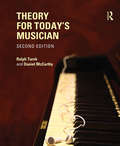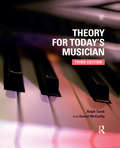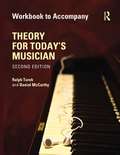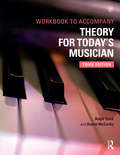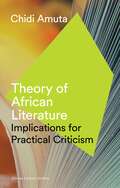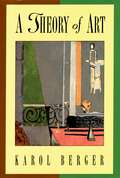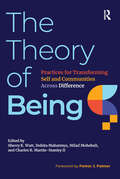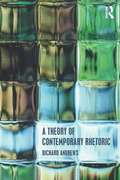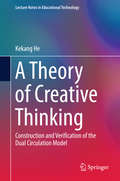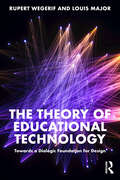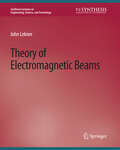- Table View
- List View
Theory for Today's Musician
by Ralph Turek Daniel McCarthyThe package (ISBN 978-0-415-73036-5) contains the second edition of Theory for Today’s Musician (ISBN: 978-0-415-66332-8) and the Theory for Today’s Musician Workbook (ISBN: 978-0-415-66333-5). The package is available for print books only. Ebook users should purchase the textbook and workbook separately. Theory for Today’s Musician, Second Edition, recasts the scope of the traditional music theory course to meet the demands of the professional music world, in a style that speaks directly and engagingly to today’s music student. It uses classical, folk, popular, and jazz repertoires with clear explanations that link music theory to musical applications. The authors help prepare students by not only exploring how music theory works in art music, but how it functions within modern music, and why this knowledge will help them become better composers, music teachers, performers, and recording engineers. This broadly comprehensive text merges traditional topics such as part-writing and harmony (diatonic, chromatic, neo-tonal and atonal), with less traditional topics such as counterpoint and musical process, and includes the non-traditional topics of popular music songwriting, jazz harmony and the blues. Written by an experienced textbook author and new co-author, both active classroom teachers for many years, Theory for Today’s Musician is the complete and ideal theory text to enable today’s student to accomplish their musical goals tomorrow. New Features to the Second Edition: An expanded unit on form that includes introductory chapters on sonata & rondo, to prepare students for learning form New "Back to Basics" online drills, keyed to the text, allowing students to brush up their fundamentals as needed New musical examples, including over 80 new musical excerpts from both art and popular music repertoires Expanded in-chapter exercises to promote and facilitate classroom interaction Carefully edited in response to market demands to create a more streamlined, flexible text New audio of musical examples (for both text and workbook), 50% re-recorded for improved audio quality An updated and relocated Chapter 33 on song composition in the jazz and popular folk styles, applying principles of text setting, melody composition/harmonization Companion website that houses online tutorial with drills of basic concepts
Theory for Today's Musician Textbook, Third Edition
by Ralph Turek Daniel McCarthyTheory for Today’s Musician, Third Edition, recasts the scope of the traditional music theory course to meet the demands of the professional music world, in a style that speaks directly and engagingly to today’s music student. It uses classical, folk, popular, and jazz repertoires with clear explanations that link music theory to musical applications. The authors help prepare students by not only exploring how music theory works in art music, but how it functions within modern music, and why this knowledge will help them become better composers, music teachers, performers, and recording engineers. This broadly comprehensive text merges traditional topics such as part writing and harmony (diatonic, chromatic, neo-tonal and atonal), with less traditional topics such as counterpoint and musical process, and includes the non-traditional topics of popular music songwriting, jazz harmony and the blues. The accompanying companion website provides interactive exercises that allow students to practice foundational theory skills. Written by experienced authors, both active classroom teachers for many years, Theory for Today’s Musician is the complete and ideal theory text to enable today’s student to accomplish their musical goals tomorrow. Updated and corrected throughout, the Third Edition includes: Expanded coverage of atonality and serialism, now separated into two chapters. Broadened treatment of cadences, including examples from popular music. Substantially rewritten chapter on songwriting. Interactive features of the text simplified to two types, "Concept Checks" and "Review and Reinforcement," for greater ease of use. New and updated musical examples added throughout. Charts, illustrations, and musical examples revised for increased clarity. Audio of musical examples now provided through the companion website. The accompanying Workbook offers exercises and assignments to accompany each chapter in the book. A companion website houses online tutorials with drills of basic concepts, as well as audio.
Theory for Today's Musician Workbook, Second Edition (eBook)
by Ralph Turek Daniel McCarthyThe package (ISBN 978-0-415-73036-5) contains the second edition of Theory for Today’s Musician (ISBN: 978-0-415-66332-8) and the Theory for Today’s Musician Workbook (ISBN: 978-0-415-66333-5). The package is available for print books only. Ebook users should purchase the textbook and workbook separately. This workbook accompanies the second edition of Theory for Today's Musician and is full of exercises to help students practice and master the concepts presented in each chapter. Audio files are included.
Theory for Today's Musician Workbook, Second Edition (eBook)
by Ralph Turek Daniel McCarthyThe package (ISBN 978-0-415-73036-5) contains the second edition of Theory for Today’s Musician (ISBN: 978-0-415-66332-8) and the Theory for Today’s Musician Workbook (ISBN: 978-0-415-66333-5). The package is available for print books only. Ebook users should purchase the textbook and workbook separately. This workbook accompanies the second edition of Theory for Today's Musician and is full of exercises to help students practice and master the concepts presented in each chapter. Audio files are included.
Theory for Today's Musician Workbook, Third Edition
by Ralph Turek Daniel McCarthyTheory for Today’s Musician, Third Edition, recasts the scope of the traditional music theory course to meet the demands of the professional music world, in a style that speaks directly and engagingly to today’s music student. It uses classical, folk, popular, and jazz repertoires with clear explanations that link music theory to musical applications. The authors help prepare students by not only exploring how music theory works in art music, but how it functions within modern music, and why this knowledge will help them become better composers, music teachers, performers, and recording engineers. This broadly comprehensive text merges traditional topics such as part writing and harmony (diatonic, chromatic, neo-tonal and atonal), with less traditional topics such as counterpoint and musical process, and includes the non-traditional topics of popular music songwriting, jazz harmony and the blues. The accompanying companion website provides interactive exercises that allow students to practice foundational theory skills. Written by experienced authors, both active classroom teachers for many years, Theory for Today’s Musician is the complete and ideal theory text to enable today’s student to accomplish their musical goals tomorrow. Updated and corrected throughout, the Third Edition includes: Expanded coverage of atonality and serialism, now separated into two chapters. Broadened treatment of cadences, including examples from popular music. Substantially rewritten chapter on songwriting. Interactive features of the text simplified to two types, "Concept Checks" and "Review and Reinforcement," for greater ease of use. New and updated musical examples added throughout. Charts, illustrations, and musical examples revised for increased clarity. Audio of musical examples now provided through the companion website. The accompanying Workbook offers exercises and assignments to accompany each chapter in the book. A companion website houses online tutorials with drills of basic concepts, as well as audio.
Theory for Today's Musician Workbook, Third Edition
by Ralph Turek Daniel McCarthyTheory for Today’s Musician, Third Edition, recasts the scope of the traditional music theory course to meet the demands of the professional music world, in a style that speaks directly and engagingly to today’s music student. It uses classical, folk, popular, and jazz repertoires with clear explanations that link music theory to musical applications. The authors help prepare students by not only exploring how music theory works in art music, but how it functions within modern music, and why this knowledge will help them become better composers, music teachers, performers, and recording engineers. This broadly comprehensive text merges traditional topics such as part writing and harmony (diatonic, chromatic, neo-tonal and atonal), with less traditional topics such as counterpoint and musical process, and includes the non-traditional topics of popular music songwriting, jazz harmony and the blues. The accompanying companion website provides interactive exercises that allow students to practice foundational theory skills. Written by experienced authors, both active classroom teachers for many years, Theory for Today’s Musician is the complete and ideal theory text to enable today’s student to accomplish their musical goals tomorrow. Updated and corrected throughout, the Third Edition includes: Expanded coverage of atonality and serialism, now separated into two chapters. Broadened treatment of cadences, including examples from popular music. Substantially rewritten chapter on songwriting. Interactive features of the text simplified to two types, "Concept Checks" and "Review and Reinforcement," for greater ease of use. New and updated musical examples added throughout. Charts, illustrations, and musical examples revised for increased clarity. Audio of musical examples now provided through the companion website. The accompanying Workbook offers exercises and assignments to accompany each chapter in the book. A companion website houses online tutorials with drills of basic concepts, as well as audio.
Theory in Context and Out (Play & Culture Studies)
by Stuart ReifelTheory in and out of Context furthers discourse and understanding about the complex phenomenon we know as play. Play, as a human and animal activity, can be understood in terms of cultural, social, evolutionary, psychological, and philosophical perspectives.This effort necessarily includes inquiry from a range of disciplines, including history, sociology, psychology, education, biology, anthropology, and leisure studies. Work from a number of those disciplines is represented in this book.This volume includes sections covering Foundations and Theory of Play, Gender and Children's Play, Theory of Mind, Adult-Child Play, and Classroom Play. Scholarly analyses and reports of research from diverse disciplines amplify our understanding of play in Western and non-Western societies.
Theory into Practice: Case Stories for School Leaders (Constructing Knowledge: Curriculum Studies in Action #3)
by Julie A. Gorlewski David A. Gorlewski Thomas M. RammingThis book does exactly what its title suggests: it takes the theoretical and conceptual nature of leadership and positions it in the real world of school governance – where teachers, administrators and community stakeholders grapple with issues of change, diversity, influence, motivation, policy, and law. Organized around the widely accepted Interstate School Leaders Licensure Consortium (ISLLC) Standards, Theory into Practice: Case Stories for School Leaders offers a rich combination of current literature on educational leadership, real-life school-based situations, and a framework for decision-making. Designed for both current and aspiring school leaders, this book provides the perfect complement to coursework and clinical experiences by offering case stories at all levels: from teacher leader, to building leader, to district leader. The case story format enables readers to experience a wide range of school-based issues from a variety of perspectives. Through this construct, the authors present a strong case for reflective leadership and thoughtful decision-making. Given the current climate of standards, standardization, and hyper-accountability in education, this book reminds readers that education – and educational leadership – remains an intensely human experience.
Theory of African Literature: Implications for Practical Criticism (African Culture Archive)
by Chidi AmutaThis groundbreaking work, first published in 1989, was one of the first to challenge the conventional critical assessment of African literature, and remains highly influential today.Amuta's key argument is that African literature can be discussed only within the wider framework of the dismantling of colonial rule and Western hegemony in Africa. In exploring the possibility of a dialectical, alternative critical base, he draws upon both classical Marxist aesthetics and the theories of African culture espoused by Fanon, Cabral and Ngugi. From these explorations, Amuta derives a new language of criticism, which is then applied to works by modern African writers as diverse as Achebe, Ousmane, Agostinho Neto and Dennis Brutus.Amuta's highly original and innovative approach remains relevant not only for assessing the literature of developing countries, but for Marxist and postcolonial theories of literary criticism more generally. The author's elegance of argument and clarity of exposition makes this a distinguished and lasting contribution to debates around cultural expression in postcolonial Africa.
A Theory of Applied Linguistics: Ιmagining and Disclosing the Meaning of Design (Educational Linguistics #65)
by Albert WeidemanThis book adopts as conceptual focus the technical mode of experience, exploring this characteristic mode of design as the angle from which the discipline of applied linguistics takes its cue. What makes applied linguistic concept formation possible? A number of elementary concepts and ideas are so basic to the discipline that they can neither be ignored nor avoided. These ‘primitives’ are identified by examining the connections among the technical and other modalities, such as the spatial, the physical, the social, economic, aesthetic, juridical and the ethical. A theory of applied linguistics must be robust enough to do justice to different modernist and postmodernist paradigms operating in the discipline, systematically identifying and assessing their strengths and blind spots. The book offers a response to the question of the usefulness of theory. The principles of design revealed in the theoretical analysis are given shape in developing imaginative language interventions to solve vexing language problems not for the sake of theory, but for the benefit of those affected. The book is intended for use both as a reference and as a comprehensive, unifying perspective of what the field is, by scholars in applied linguistics and related fields (TESOL, ESL, ESP, EAP, SLA studies, language assessment and testing, language policy development), by postgraduate students or those who teach or study applied linguistics.
A Theory of Art
by Karol BergerWhat, if anything, has art to do with the rest of our lives, and in particular with those ethical and political issues that matter to us most? Will art created today be likely to play a role in our lives as profound as that of the best art of the past? A Theory of Art shifts the focus of aesthetics from the traditional debate of "what is art?" to the engaging question of "what is art for?" Skillfully describing the social and historical situation of art today, author Karol Berger argues that music exemplifies the current condition of art in a radical, acute, and revealing fashion. He also uniquely combines aesthetics with poetics and hermeneutics. Offering a careful synthesis of a wide breadth of scholarship from art history, musicology, literary studies, political philosophy, ethics, and metaphysics, and written in a clear, accessible style, this book will appeal to anyone with a serious interest in the arts.
The Theory of Being: Practices for Transforming Self and Communities Across Difference
by Sherry K. Watt Duhita Mahatmya Milad Mohebali Charles R. Martin-StanleyThis book presents a state-of-the-art, robust, and adaptable process, the Theory of Being, that offers strategies for working across Difference, and for embarking on constructive dialogue around the issues that drive us apart, both individually and collectively. Whether around racial, gender, and/or social class inequity, core beliefs, uses of power or other points of cultural conflict, this book offers a research-validated approach, developed and refined over twenty years, to engage in difficult dialogues. The Theory of Being includes personal, relational, and community practices that support individuals and communities to better work through the difficult dialogues necessary to transform systems of structural inequity. It describes and offers applications of Being to help the reader understand and apply principles and practices that invite openness to controversy through facilitating deep reflection and shifting the focus of conflict from individuals to centering the issue of contention as a Third Thing about which participants can more safely express experiences and emotions.Via cases and narratives, the editors and contributors demonstrate how, through productively situating feelings of vulnerability and anger, individuals, organizations, and communities can work together to continuously evolve responsive, inclusive, and equitable practices that value social and cultural differences. This book focuses on strategies for the “how” we interact, demonstrating an orientation to process rather than prioritizing outcomes. A process-orientation can increase the quality of interaction between individuals, and the likelihood of traversing problems associated with controversial social difference in ways that result in sustainable strategies to disrupt systems of oppression. A range of applications exemplify this approach throughout the text.The primary audience is higher education leaders and leaders-in-training including student affairs professional staff, campus administrators, higher education and student affairs faculty, and undergraduate and graduate students. However, the approach has broad implications for any persons who want to productively engage across Difference in their personal and/or professional lives.
The Theory of Being: Practices for Transforming Self and Communities Across Difference
This book presents a state-of-the-art, robust, and adaptable process, the Theory of Being, that offers strategies for working across Difference, and for embarking on constructive dialogue around the issues that drive us apart, both individually and collectively. Whether around racial, gender, and/or social class inequity, core beliefs, uses of power or other points of cultural conflict, this book offers a research-validated approach, developed and refined over twenty years, to engage in difficult dialogues. The Theory of Being includes personal, relational, and community practices that support individuals and communities to better work through the difficult dialogues necessary to transform systems of structural inequity. It describes and offers applications of Being to help the reader understand and apply principles and practices that invite openness to controversy through facilitating deep reflection and shifting the focus of conflict from individuals to centering the issue of contention as a Third Thing about which participants can more safely express experiences and emotions.Via cases and narratives, the editors and contributors demonstrate how, through productively situating feelings of vulnerability and anger, individuals, organizations, and communities can work together to continuously evolve responsive, inclusive, and equitable practices that value social and cultural differences. This book focuses on strategies for the “how” we interact, demonstrating an orientation to process rather than prioritizing outcomes. A process-orientation can increase the quality of interaction between individuals, and the likelihood of traversing problems associated with controversial social difference in ways that result in sustainable strategies to disrupt systems of oppression. A range of applications exemplify this approach throughout the text.The primary audience is higher education leaders and leaders-in-training including student affairs professional staff, campus administrators, higher education and student affairs faculty, and undergraduate and graduate students. However, the approach has broad implications for any persons who want to productively engage across Difference in their personal and/or professional lives.
A Theory of Catholic Education
by Sean WhittlePresenting a robust and philosophically based account of education from the Catholic point of view, Sean Whittle engages with important debates and questions concerning the nature and purpose of Catholic education and schooling. The book opens with a review of the criticisms that have emerged about the prevalence of Catholic schools within the state system and, indeed, about the very notion of there being such a thing as 'Catholic education'. The author then goes on to survey official Church teaching on education and the work of key Catholic thinkers, Newman and Maritain, before moving on to discuss the writings of Karl Rahner, a leading twentieth century theologian. A Theory of Catholic Education argues that Rahner's approach, with his focus on the place of mystery in human experience, provides a way forward. Ultimately, Whittle demonstrates how Catholic theology can offer a unique and much needed theory of education.
A Theory of Catholic Education
by Sean WhittlePresenting a robust and philosophically based account of education from the Catholic point of view, Sean Whittle engages with important debates and questions concerning the nature and purpose of Catholic education and schooling. The book opens with a review of the criticisms that have emerged about the prevalence of Catholic schools within the state system and, indeed, about the very notion of there being such a thing as 'Catholic education'. The author then goes on to survey official Church teaching on education and the work of key Catholic thinkers, Newman and Maritain, before moving on to discuss the writings of Karl Rahner, a leading twentieth century theologian. A Theory of Catholic Education argues that Rahner's approach, with his focus on the place of mystery in human experience, provides a way forward. Ultimately, Whittle demonstrates how Catholic theology can offer a unique and much needed theory of education.
Theory of Change: Debates and Applications to Access and Participation in Higher Education (Great Debates in Higher Education)
by Samuel Dent Anna Mountford-Zimdars Ciaran BurkeTheory of Change speaks to those looking for an academically rigorous discussion of the origins and debates around this approach in Higher Education. Melding together robust academic research with examples of practice, the book provides specific applications of using a Theory of Change across key stages of the student life cycle. The Theory of Change underpinning this book is that national and international practitioners, policy makers, higher education professionals, students and academic faculty will increase awareness and ability to use a Theory of Change in their own work. This, in turn, will mainstream the use which will lead to better interventions and practices. In the field of access and participation in higher education, it will ultimately lead to more disadvantaged students entering and successfully progressing from higher education. This book helps to establish a common lexicon around a Theory of Change approach and enable discussion of demonstrable, meaningful reflections on the ‘change’ work has on inequalities in higher education access and participation.
Theory of Change: Debates and Applications to Access and Participation in Higher Education (Great Debates in Higher Education)
by Samuel Dent, Anna Mountford-Zimdars, Ciaran BurkeTheory of Change speaks to those looking for an academically rigorous discussion of the origins and debates around this approach in Higher Education. Melding together robust academic research with examples of practice, the book provides specific applications of using a Theory of Change across key stages of the student life cycle. The Theory of Change underpinning this book is that national and international practitioners, policy makers, higher education professionals, students and academic faculty will increase awareness and ability to use a Theory of Change in their own work. This, in turn, will mainstream the use which will lead to better interventions and practices. In the field of access and participation in higher education, it will ultimately lead to more disadvantaged students entering and successfully progressing from higher education. This book helps to establish a common lexicon around a Theory of Change approach and enable discussion of demonstrable, meaningful reflections on the ‘change’ work has on inequalities in higher education access and participation.
A Theory of Contemporary Rhetoric
by Richard AndrewsA Theory of Contemporary Rhetoric describes, explains, and argues the overarching theory of contemporary rhetoric. This current view of rhetoric brings together themes in the communication arts, including political literary criticism; bi- and multi-lingualism; multimodality; framing as an artistic and sociological device for composition and interpretation; literacy in the digital age; and the division between fiction and ‘non-fiction’ in language/literature studies. Chapters explore the implications of rhetoric for particular aspects of the field. Discussions throughout the book provide illustrations that ground the material in practice. As an overarching theory in the communication arts, rhetoric is elegant as a theoretical solution and simple as a practical one. It asks such questions as who is speaking/writing/composing? to whom? why? what is being conveyed? and how is it being conveyed? Acknowledging the dirth of recent works addressing the theory of rhetoric, this book aims to fill the existing theoretical gap and at the same time move the field of language/literature studies forward into new territory. It provides the keynote theoretical guide for a generation of teachers, teacher educators and researchers in the fields of English as a subject; English as a second, foreign or additional language; and language study in general.
A Theory of Contemporary Rhetoric
by Richard AndrewsA Theory of Contemporary Rhetoric describes, explains, and argues the overarching theory of contemporary rhetoric. This current view of rhetoric brings together themes in the communication arts, including political literary criticism; bi- and multi-lingualism; multimodality; framing as an artistic and sociological device for composition and interpretation; literacy in the digital age; and the division between fiction and ‘non-fiction’ in language/literature studies. Chapters explore the implications of rhetoric for particular aspects of the field. Discussions throughout the book provide illustrations that ground the material in practice. As an overarching theory in the communication arts, rhetoric is elegant as a theoretical solution and simple as a practical one. It asks such questions as who is speaking/writing/composing? to whom? why? what is being conveyed? and how is it being conveyed? Acknowledging the dirth of recent works addressing the theory of rhetoric, this book aims to fill the existing theoretical gap and at the same time move the field of language/literature studies forward into new territory. It provides the keynote theoretical guide for a generation of teachers, teacher educators and researchers in the fields of English as a subject; English as a second, foreign or additional language; and language study in general.
A Theory of Creative Thinking: Construction and Verification of the Dual Circulation Model (Lecture Notes in Educational Technology)
by Kekang HeThis book examines research on creative thinking, both current and historical. It explores two dimensions of human thought (time and space) and two modes of thinking (conscious and unconscious) as well as both left and right brain functions and artistic and scientific creative activities. The book proposes a "Double Circulation” model of creative thinking and argues that imagery thinking, intuitive thinking and logical thinking are main parts of creative thinking and that dialectical thinking and horizontal-vertical thinking are the guides for highly complex problem-solving thoughts and strategies.The book focuses on education and psychology and also covers how to use ICT to promote students’ creative thinking skills.Researchers will benefit from the "Double Circulation" model, which provides a new perspective on conducting creative thinking research. The book is also a valuable resource for graduate students in the fields of educational technology and psychology and for all readers who are interested in creative thinking.
Theory of Didactical Situations in Mathematics: Didactique des Mathématiques, 1970–1990 (Mathematics Education Library #19)
by Guy BrousseauThis book is unique. It gathers texts which give the best presentation of the principles and key concepts of the Theory of Didactical Situations that Guy Brousseau developed in the period from 1970 to 1990. These texts provide a comprehensive presentation of the Theory. In order to facilitate the reading of certain points footnotes have been added, as well as preludes and interludes to place in context the chosen texts and clarify the construction of the book.
Theory of Education
by David A. TurnerTo date, theory in Education Studies has been dominated by a particular view of what should count as 'scientific' theory. David Turner argues that this approach does not necessarily provide a firm foundation for policy planning and professional activity. Using examples from linear programming, game theory, decision theory and chaos theory, he demonstrates how certain insights from modern developments in, for example, the social sciences can be used to stimulate more rewarding debate amongst educational researchers.
The Theory of Educational Technology: Towards a Dialogic Foundation for Design
by Rupert Wegerif Louis MajorEducational technology is controversial – some see it as essential to providing free global learning, others view it as a dangerous distraction that undermines good education. In both instances, most theories that have previously been applied to educational technology do not account for the distinctive nature and vast potential of technology. This book addresses this issue, exploring how education has been bound up with technology from the beginning, and recognising that educational aims have already been shaped by technologies. Offering a ‘dialogic’ theory of educational technology, Rupert Wegerif and Louis Major respond to contemporary challenges to education within this book, including, but not limited to, climate change, misinformation on the internet and the impact of Artificial Intelligence. Chapters introduce, discuss, and contextualise key theories and illustrate through case studies their uses within a diverse range of educational contexts, spanning from primary education to adult lifelong learning. Each chapter also concludes with a short summary, demonstrating how these theories translate to practical implications for design. A fascinating response to current developments in educational technology, this is a crucial read for all involved in creating, researching or making decisions about the use of technologies within educational contexts.
The Theory of Educational Technology: Towards a Dialogic Foundation for Design
by Rupert Wegerif Louis MajorEducational technology is controversial – some see it as essential to providing free global learning, others view it as a dangerous distraction that undermines good education. In both instances, most theories that have previously been applied to educational technology do not account for the distinctive nature and vast potential of technology. This book addresses this issue, exploring how education has been bound up with technology from the beginning, and recognising that educational aims have already been shaped by technologies. Offering a ‘dialogic’ theory of educational technology, Rupert Wegerif and Louis Major respond to contemporary challenges to education within this book, including, but not limited to, climate change, misinformation on the internet and the impact of Artificial Intelligence. Chapters introduce, discuss, and contextualise key theories and illustrate through case studies their uses within a diverse range of educational contexts, spanning from primary education to adult lifelong learning. Each chapter also concludes with a short summary, demonstrating how these theories translate to practical implications for design. A fascinating response to current developments in educational technology, this is a crucial read for all involved in creating, researching or making decisions about the use of technologies within educational contexts.
Theory of Electromagnetic Beams (Synthesis Lectures on Engineering, Science, and Technology)
by John LeknerThe theory of electromagnetic beams is presented in a simple and physical way, with all necessary mathematics explained in the text. The topics covered are in free-space classical electrodynamics, but contact is made with quantum theory in proofs that causal beams of various kinds can be viewed as superpositions of photons. This follows from explicit expressions for the energy, momentum and angular momentum per unit length for each type of beam. The properties of beams in the focal region, of special experimental and theoretical interest, are discussed in detail. There are eight chapters: on Fundamentals, Beam-like solutions of the Helmholtz equation, Electromagnetic beams, Polarization, Chirality, Comparison of electromagnetic beams, a chapter on Sound beams and particle beams (to show the similarities to and differences from the vector electromagnetic beams), and a final chapter on Measures of focal extent. Ten Appendices cover mathematical or associated physical topics.
